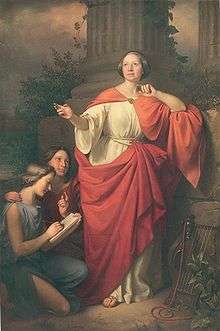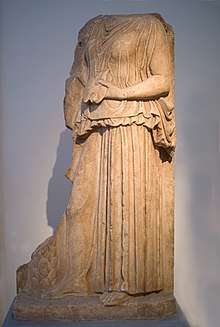Diotima of Mantinea
Diotima of Mantinea (/ˌdaɪəˈtaɪmə/; Greek: Διοτίμα; Latin: Diotīma) was an ancient Greek prophetess and philosopher thought to have lived circa 440 B.C., who plays an important role in Plato's Symposium. In the dialogue, her ideas are the origin of the concept of Platonic love.
Diotima of Mantinea | |
|---|---|
| Era | Ancient philosophy |
| Region | Western philosophy |
| School | Classical Greek |
Notable ideas | Platonic love |
Identity

The name Diotima means one who honors or is honored by Zeus, and her Mantinean origin is reminiscent of the root "mantis", which would suggest an association with prophecy. The Greek form also includes the sound nike: Diotima Mantinike as a pun in Greek would thus sound like "Diotima from Prophet-victory".[1]
In the Symposium, she is implied to be a priestess or prophetess and is said to be from the Peloponnesian city of Mantinea, which was allied against Athens at the time of the dialogue - though one version of the manuscript preferred in old readings called her a mantic woman, or seeress, rather than a woman from Mantinea.[2][3]
Since the only contemporaneous source concerning her is Plato, doubts have been raised about whether she was a real historical personage or merely a fictional creation; however, nearly all of the characters named in Plato's dialogues have been found to correspond to real people living in ancient Athens.[4]
Plato was thought by most 19th and early 20th century scholars to have based Diotima on Aspasia, the mistress of Pericles, so impressed was he by her intelligence and wit. However, Aspasia appears under her own name in Plato's dialogue Menexenus, and some scholars have convincingly argued that Plato did not use false names; therefore, Diotima could be a historical figure.[5] In the Symposium, Diotima puts forth ideas that are different from both Socrates's and Plato's, thereby representing a different philosophical position. Socrates also claims to have learned from her. Both of these instances in Plato's dialogue have been used to argue for her existence.[6]
A first century bronze relief found in Pompeii depicts Socrates and an unnamed female figure, along with a winged Eros; although some have supposed the seated woman in the image to be Diotima, others have argued her appearance (notably a necklace) would suggest she is in fact more likely to be Aphrodite or Aspasia. Writings from the second through the fifth centuries A.D. refer to Diotima as a real person, although Plato is probably their only basis for this. The suggestion that she was a fictional creation was not introduced until the 15th century (notably by Marsilio Ficino), probably based on the fact that she was a woman;[7] however, this plausible hypothesis (with numerous parallels in the study of Platonic dialogues, for instance Callicles in the Gorgias) was in fact put forward because Diotima is not mentioned by contemporary or near-contemporary sources and because her very name and origin could be understood as symbolic.
Role in Symposium
In Plato's Symposium the members of a party discuss the meaning of love. Socrates says that in his youth he was taught "the philosophy of love" by Diotima, who was a seer or priestess. Socrates also claims that Diotima successfully postponed the Plague of Athens. In a dialogue that Socrates recounts at the symposium, Diotima says that Socrates has confused the idea of love with the idea of the beloved. Love, she says, is neither fully beautiful nor good, as the earlier speakers in the dialogue had argued. Diotima gives Socrates a genealogy of Love (Eros), stating that he is the son of "resource (poros) and poverty (penia)". In her view, love drives the individual to seek beauty, first earthly beauty, or beautiful bodies. Then as a lover grows in wisdom, the beauty that is sought is spiritual, or beautiful souls. For Diotima, the most correct use of love of other human beings is to direct one's mind to love of wisdom, or philosophy.[8] The beautiful beloved inspires the mind and the soul and directs one's attention to spiritual things. One proceeds from recognition of another's beauty, to appreciation of Beauty apart from any individual, to consideration of Divinity, the source of Beauty, to love of Divinity.
. . . and directing his gaze from now, on towards beauty as a whole, he should turn to the great ocean of beauty, and in contemplation of it give birth to many beautiful and magnificent speeches and thoughts in the abundance of philosophy. (Diotima to Socrates in Plato's Symposium.)

Recent interpretations
Beginning in the 1980s, the dehistoricization of Diotima became a subject of interest for several scholars, including Mary Ellen Waithe.[7] In 2005, Margaret Urban Walker summarized Waithe's research, stating that "the evidence for Diotima's reality is substantial, even if not conclusive, and that her imaginary status appears to be a fifteenth-century fiction that stuck."[9]
In 2019 the Oxford classical scholar Armand D'Angour published Socrates in Love: The Making of a Philosopher, presenting for the first time a wholly new case for identifying Diotima with Aspasia. His historical arguments are based on 1) the likelihood of Aspasia's involvement in the warding off of plague that Athenians will have expected to be brought on by Pericles' irreligious actions (e.g. failure to bury the dead) after his campaign against Samos in 440-39 2) the fact that 'Diotima' means 'honored by/honoring Zeus'; Pericles was called 'Zeus' in comedy and popular parlance, and he was notorious for the unusual honor that he bestowed on Aspasia.
Influence and use of name
"Diotima" has often been used as a title for philosophical or artistic projects, journals, essays, etc.:
- Polish writer Jadwiga Łuszczewska (1834–1908) used the pen name Diotima (Deotyma).
- German poet Friedrich Hölderlin used Diotima as an alias for Susette Borkenstein Gontard, who inspired him to write Hyperion. In this work, the fictitious first-person author Hyperion addresses letters to his friends Bellarmin and Diotima.
- Italian composer Luigi Nono used her name as part of the title of his string quartet: Fragmente-Stille, an Diotima, including quotations from Hölderlin's letters to Diotima from Hyperion in the work.
- Diotima is the namesake of one of the main female protagonists in The Man Without Qualities by Robert Musil.
- Diotima was the name of Leni Riefenstahl's character in the silent film The Holy Mountain.
- Diotima appears in the short poem "Irpen'" by Boris Pasternak.
- Diotima teaches Socrates and Giannina the meaning of love in Giannina Braschi's postcolonial dramatic novel United States of Banana.
- Diotima of Mantinea is one of the two main characters in novels by Gary Corby, including The Pericles Commission, The Ionia Sanction and Sacred Games.
- Diotima is the name of New York-based experimental black metal band Krallice's third album.
- Asteroid 423 Diotima is named after her.
- Diotima is used in the sorority Beta Sigma Phi.
- Skirmishes for Diotima is the name of the seventh track of The Hyperion Machine, the tenth album released by the Luxembourgish neofolk band ROME.
- Diotima is the name of a lovely pen roman and italic typeface designed by Gudrun_Zapf-von_Hesse, modelled upon her calligraphy. Originally punchcut by Stempel for hand typesetting, but adapted for use in later typesetting technologies by Linotype/Stempel.
Notes
- Evans, Nancy. "Diotima and Demeter as Mystagogues in Plato's Symposium." Hypatia, vol. 21, no. 2, 2006, pp. 1–27. JSTOR 3810989.
- Riegel, Nicholas (2016). Cosmópolis: mobilidades culturais às origens do pensamento antigo. Eryximachus and Diotima in Plato’s Symposium: Imprensa da Universidade de Coimbra. ISBN 978-989-26-1287-4.
- Grote, George (1888). Plato and the Other Companions of Sokrates. Chapter XXVI.
- Ruby Blondell The Play of Character in Plato's Dialogues, Cambridge University Press, 2002, p.31
- Wider, Kathleen. "Women philosophers in the Ancient Greek World: Donning the Mantle". Hypatia vol 1 no 1 Spring 1986. Part of her argument focuses on the point that all scholars who argued "for" a fictitious Diotima were male, and most used as a starting point Smith's uncertainty of her historical existence (Smith, Dictionary of Greek and Roman Biography and Mythology, 1870).
- Salisbury, Joyce (2001). Encyclopedia of women in the ancient world. ABC-CLIO. ISBN 978-1576070925. OCLC 758191338.
- Waithe, Mary Ellen (1987). "Diotima of Mantinea". In Waithe, Mary Ellen (ed.). A History of Women Philosophers: Volume I: Ancient Women Philosophers, 600 BC–500 AD. Dordrecht: Martinus Nijhoff. pp. 83–116. ISBN 9789024733484. Retrieved October 10, 2018.
- Plato, Symposium, 210a–212b
- Urban Walker, Margaret (Summer 2005). "Diotima's Ghost: The Uncertain Place of Feminist Philosophy in Professional Philosophy". Hypatia. 20 (3): 153–164. doi:10.2979/hyp.2005.20.3.153. JSTOR 3811120.
References
- Navia, Luis E., Socrates, the man and his philosophy, pp. 30, 171. University Press of America ISBN 0-8191-4854-7.
- Evans, Nancy. “Diotima and Demeter as Mystagogues in Plato's Symposium.” Hypatia, vol. 21, no. 2, 2006, pp. 1–27. http://www.jstor.org/stable/3810989.